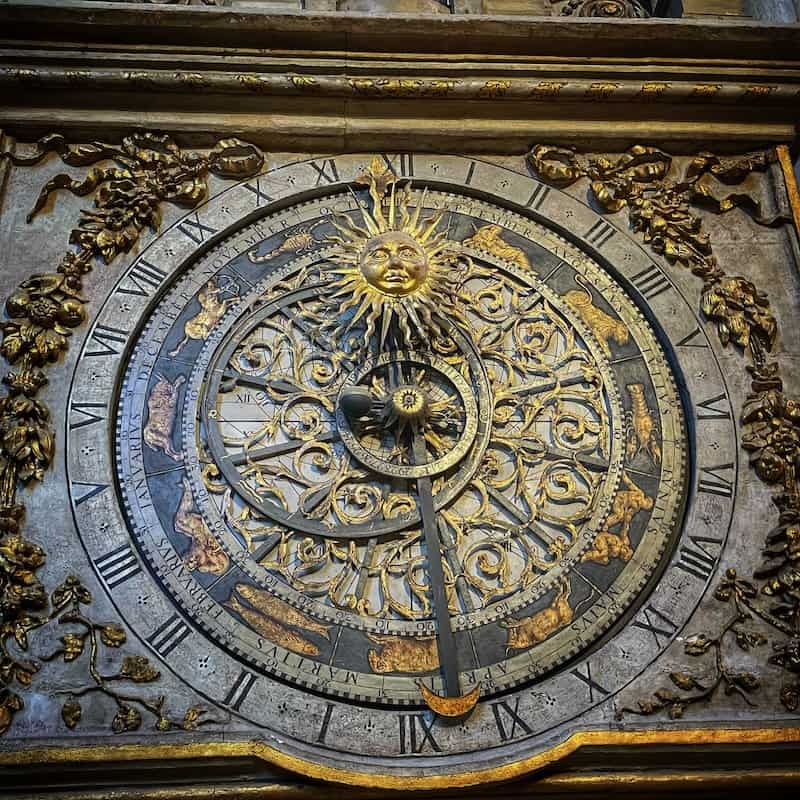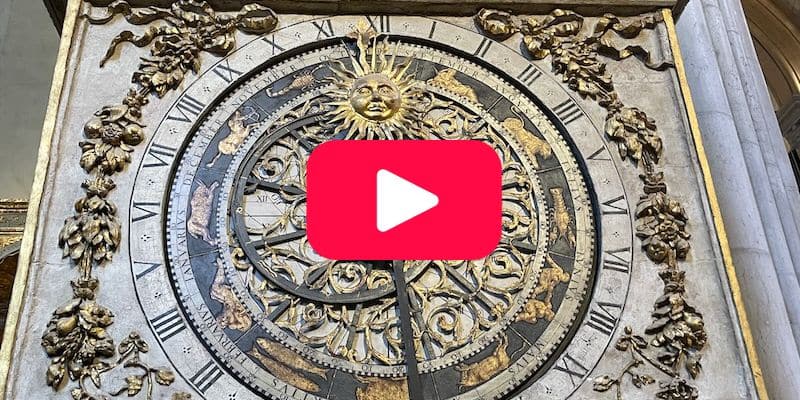Unsure about your French table manners? Click Here to download > > How to avoid these 10 food etiquette mistakes !
- Home ›
- Destinations ›
- Lyon ›
- Astronomical Clock
The Lyon Astronomical Clock: A Magical 650-year-old Timepiece
Published 05 November 2023 by Leyla Alyanak — Parisian by birth, Lyonnaise by adoption, historian by passion
It took me several visits to Lyon to unearth this gem, but once I found
it, it was love at first sight. Each time I go to Lyon, I stop here to greet
the Lyon astronomical clock.
The first few times I visited Saint-Jean Cathedral in Lyon, I took a quick look around, snapped a few photographs, and left.
I missed the best part!
Hidden in a corner on the left, towards the front of the church, is a magical structure that tells the time. And the months and days. And the main religious holidays.
As soon as I heard about it, I knew I had to go back.
This is what the stunning original astronomical time clock looked like. Until 2013.
 This is the splendid piece of machinery I should have seen...
This is the splendid piece of machinery I should have seen...And then it looked like this:
 And this is how it has remained for years
And this is how it has remained for yearsMany Lyonnais remember the date: 23 March 2013.
This was the day a man attacked the ancient clock – which dates back to 1379 – with a metal rod, savagely breaking its casing and two of its arms. He was overcome by visitors in the church and eventually arrested and placed in psychiatric care: he believed the "magnificence of the clock prevented the faithful from concentrating on prayer".
For years, the clock languished, until repairs finally started, with the clock set to be functional sometime in 2024.
What is so special about Lyon's astronomical clock?
You mean beyond the fact that it is centuries old and (barring the vandalism) still in working order?
It is a thing of beauty.
Your eyes will be drawn by the moon and the sun chasing one another across the skies, and its intricacy can hold your gaze.
It is huge.
It is 9 meters high (30 feet). If you count the rooster sitting on the dome, you'll be up to 9.5 meters.
It is an important religious piece.
Not only is it a perpetual calendar, but also an ecclesiastical one, tracking such religious holidays as Ash Wednesday, Easter, Pentecost and Advent.
If the clock could talk, it would probably tell us it is linking the spiritual and earthly realms.
It is unique.
Despite all the work that has been done on it, the clock is the only one in France that still has its original inner workings, most made of wrought iron.

It may not be the oldest astronomical clock in Europe, but is definitely one of the oldest.
Where
you'll find the clock
Even if you don't care about clocks or astrolabes or religious holidays, this clock is worth your time as you enter the maze of Old Lyon.
It is located inside the Saint Jean-Baptiste Cathedral, seat of Lyon's Archdiocese. In other words, this is the home of Lyon's Archbishop.
The building of the cathedral began in 1180 (an even older church was beneath it) and took 300 years to finish. It was worth the wait, since the church is now, along with other parts of Lyon, on the UNESCO World Heritage List.
 The front of the Cathedral - the clock is inside
The front of the Cathedral - the clock is insideIt is a handsome cathedral, and until the Basilica was built on Fourvière Hill, it was Lyon's main Catholic church.
The story behind the astronomical clock in Lyon
According to legend, and legend there is, this being France, the king of the Ostrogoths, Theodoric, gave Lyon's church authorities a "water clock", or clepsydra.
Since Theodoric (the Great) lived from 454-526 CE, that largely predates the present Cathedral, which may mean that the older church upon which it is built may also have contained a clock.
We don't know.
However, most accounts agree the astronomical clock was built in 1379, and the existence of a clock inside the Cathedral was first mentioned officially in 1383, just four years later.
What is less clear is how much of this clock is original.
It is believed much of the original clock was destroyed in 1562 during the Wars of Religion in what is known as the Sac des Adrets, or Sac de Lyon, "sac" meaning to sack or ransack, in this case (usually the word simply means a bag, or purse).
For a short time, Protestants took over Lyon, a Catholic city, and destroyed many Catholic symbols, including the Cathedral's statuary – and much of its clock.
 The sack of Lyon by Calvinists in 1562 under the command of the Baron des Adrets (Unknown, formerly attributed to Pierre Caron, Public domain, via Wikimedia Commons)
The sack of Lyon by Calvinists in 1562 under the command of the Baron des Adrets (Unknown, formerly attributed to Pierre Caron, Public domain, via Wikimedia Commons)By 1598, the religious wars had ended. France's Protestant King Henry IV converted to Catholicism and issued the Edict of Nantes, under which Protestantism was no longer illegal.
Lyonnais master clockmaker Hugues Levet, with the help of Johannes Lippius, a mathematician and astronomer, set out to repair the damaged clock. In 1660, the finishing touches were added by Guillaume Nourisson, a watchmaker and expert in automatons – and what we see today is the result of his work.
In the late 1700s, a new clock mechanism was added, as was the Swiss guard automaton, but the clock would again be damaged, this time during the French Revolution, when anti-monarchism was at its peak. All royal insignia and most ornaments would be stripped from the clock.
The timepiece was again restored in 1954, and again in the early 1990s. The present repairs following the 2013 aggression are the latest of the restorations.
But we still don't know how much of the original clock remains.
We'll never know, but if you ask any authorities in Lyon, they'll tell you the clock dates back to 1379, regardless of what survived.
What the
astronomical timeclock looks like
The clock is incredibly complex.
Its facade has two statuettes, one of Saint Pothinus, Lyon's first bishop, and Saint Irenaeus, its second.
Once the clock is again in working order, if tradition is observed, the automatons will begin their dance at noon, 2pm, 3pm and 4pm: the angel on the left will upend his hourglass, while the one of the right conducts the orchestra.
Then the rooster will crow three times, stretching its neck and flapping its wings.
All sorts of things happen! Angels hammer the bells while playing hymns, the Swiss guard twirls and waves to the crowd, Mary faces the Angel Gabriel, the "Celestial Father" blesses the crowd, and the Swiss guard ends his watch as the big bell under the rooster clangs the hour.
This little video (a bit blurry) gives you an idea of what it was like before the attack (and what it should be like again once it's fixed).
How it works
It's difficult to imagine that this is a medieval astronomical clock, developed without the help of computers or even calculators.
It is nonethelss complex, displaying the time and the date along with plenty of astronomical data, like the phases of the moon and the position of the planets and the sun. And let's not forget its accurate prediction of dates and religious holidays!
Other European astronomical clocks
During the Middle Ages, these clocks were often built for show, to demonstrate know-how and complexity.
They were a badge of wealth and power, their monumental works adorning churches and city halls.
France still has 40 or so astronomical clocks, most of them not as old as Lyon's. The clock in Strasbourg dates back to 1354, but most of the rest are more recent, from Bourges in 1423 to recent ones built in the late 20th century. One of the most famous is of course the Gros Horloge in Rouen, built sometime during the 15th century.
Elsewhere in Europe, perhaps the most famous is the Prague Orloj, built sometime in the early 15th century, which is believed to the be the world's oldest working astronomical clock. They abound in Europe's northern half.
Before you go...
This amazing clock is smack at the entrance of Vieux Lyon, and is easy to get to. You'll have to pass the Cathedral to visit the Old Town, so drop in for a second to admire the clock.
And if you happen to be going up to Fourvière to visit the Basilica (one of the best things to do in Lyon) or see the old Roman ruins, you'll be taking the funicular up just a block from the Cathedral. Take a little detour, and see something few tourists even know is there.


